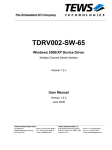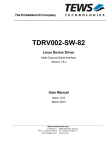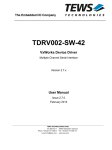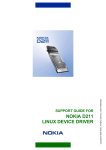Download User Manual - powerbridge.de
Transcript
The Embedded I/O Company TDRV002-SW-95 QNX6-Neutrino Device Driver Multiple Channel Serial Interface Version 1.2.x User Manual Issue 1.2.0 April 2012 TEWS TECHNOLOGIES GmbH Am Bahnhof 7 25469 Halstenbek, Germany Phone: +49 (0) 4101 4058 0 Fax: +49 (0) 4101 4058 19 e-mail: [email protected] www.tews.com TDRV002-SW-95 This document contains information, which is proprietary to TEWS TECHNOLOGIES GmbH. Any reproduction without written permission is forbidden. QNX6-Neutrino Device Driver Multiple Channel Serial Interface TEWS TECHNOLOGIES GmbH has made any effort to ensure that this manual is accurate and complete. However TEWS TECHNOLOGIES GmbH reserves the right to change the product described in this document at any time without notice. Supported Modules: TPMC371 TPMC372 TPMC375 TPMC376 TPMC377 TPMC460 TPMC461 TPMC462 TPMC463 TPMC465 TPMC466 TPMC467 TPMC470 TCP460 TCP461 TCP462 TCP463 TCP465 TCP466 TCP467 TCP469 TCP470 TXMC375 TEWS TECHNOLOGIES GmbH is not liable for any damage arising out of the application or use of the device described herein. 2005-2013 by TEWS TECHNOLOGIES GmbH Issue Description Date 1.0.0 First Issue September 27, 2005 1.0.1 TPMC467/TCP467 support added, modified file list February 2, 2007 1.0.2 Modification for devc-devices and QNX6.3.x with SPx February 23, 2007 1.0.3 Description of installation corrected, “Avoiding Data Loss” added, Address TEWS LLC removed October 7, 2010 1.1.0 TPMC377, TPMC470, TCP469 and TCP470 support added May 4, 2011 1.2.0 New Files added to file list, TXMC375 support added devctl-function TDRV002_DCMD_SET_TRANSC added April 4, 2013 TDRV002-SW-95 –QNX6-Neutrino Device Driver Page 2 of 19 Table of Contents 1 2 INTRODUCTION......................................................................................................... 4 INSTALLATION.......................................................................................................... 5 2.1 2.2 2.3 2.4 3 Build the Device Driver...................................................................................................................6 Start the Driver Process .................................................................................................................7 Configuration File .........................................................................................................................10 Avoiding Data Loss.......................................................................................................................12 DEVICE INPUT/OUTPUT FUNCTIONS ................................................................... 13 3.1 open................................................................................................................................................13 3.2 close ...............................................................................................................................................15 3.3 devctl..............................................................................................................................................16 3.3.1 TDRV002_DCMD_SET_TRANSC ...................................................................................18 TDRV002-SW-95 –QNX6-Neutrino Device Driver Page 3 of 19 1 Introduction The TDRV002-SW-95 QNX6-Neutrino device driver is a full-duplex serial device driver which allows the operation of TDRV002 serial devices on Intel x86 based QNX6-Neutrino operating systems. The TDRV002-SW-95 device driver is based on the standard QNX6 8250 serial communication manager. Due to this way of implementation the driver interface and function is compatible to the standard QNX6 serial device manager. All standard utility programs for configuration (e.g. stty) and maintaining terminal interfaces can be used in the same manner. Additional supported features: Receive and transmit FIFO trigger levels are configurable during driver start up Configuration of programmable interface. (If hardware supports programmable interface) The TDRV002-SW-95 device driver supports the modules listed below: TPMC371 8 Channel Serial Interface PMC Conduction Cooled TPMC372 4 Channel Serial Interface PMC Conduction Cooled TPMC375 8 Chan. Serial Interface (prog. Transceiver) PMC Conduction Cooled TPMC376 4 Chan. Serial Interface (prog. Transceiver) PMC Conduction Cooled TPMC377 4 Chan. Isolated Serial Interface (prog. Transc.) PMC Conduction Cooled TPMC460 16 Channel Serial Interface PMC TPMC461 8 Channel Serial Interface PMC TPMC462 4 Channel Serial Interface PMC TPMC463 4 Channel Serial Interface PMC TPMC465 8 Chan. Serial Interface (prog. Transceiver) PMC TPMC466 4 Chan. Serial Interface (prog. Transceiver) PMC TPMC467 4 Chan. Serial Interface (prog. Transceiver) PMC TPMC470 4 Chan. Isolated Serial Interface (prog. Transc.) PMC TCP460 16 Channel Serial Interface CompactPCI TCP461 8 Channel Serial Interface CompactPCI TCP462 4 Channel Serial Interface CompactPCI TCP463 4 Channel Serial Interface CompactPCI TCP465 8 Chan. Serial Interface (prog. Transceiver) CompactPCI TCP466 4 Chan. Serial Interface (prog. Transceiver) CompactPCI TCP467 4 Chan. Serial Interface (prog. Transceiver) CompactPCI TCP469 8 Chan. Isolated Serial Interface (prog. Transc.) CompactPCI TCP470 4 Chan. Isolated Serial Interface (prog. Transc.) CompactPCI TXMC375 8 Chan. Serial Interface (prog. Transceiver) XMC Conduction Cooled In this document all supported modules and devices will be called TDRV002. Specials for certain devices will be advised. TDRV002-SW-95 –QNX6-Neutrino Device Driver Page 4 of 19 2 Installation The directory TDRV002-SW-95 on the distribution media contains the following files: TDRV002-SW-95-SRC.tar.gz TDRV002-SW-95-1.2.0.pdf Release.txt ChangeLog.txt Driver source archive This manual in PDF format Release information Release history The TAR archive TDRV002-SW-95-SRC.tar.gz contains the following files and directories: tdrv002/driver/nto/x86/o/Makefile tdrv002/driver/nto/x86/Makefile tdrv002/driver/nto/Makefile tdrv002/driver/common.mk tdrv002/driver/common.mk-nops tdrv002/driver/common.mk-nopm tdrv002/driver/externs.c tdrv002/driver/externs.h tdrv002/driver/init.c tdrv002/driver/intr.c tdrv002/driver/main.c tdrv002/driver/Makefile tdrv002/driver/options.c tdrv002/driver/devctlext.c tdrv002/driver/proto.h tdrv002/driver/tedit.c tdrv002/driver/tdrv002.h tdrv002/driver/tto.c tdrv002/driver/tdrv002config.txt tdrv002/example/nto/x86/o/Makefile tdrv002/example/nto/x86/Makefile tdrv002/example/nto/Makefile tdrv002/example/common.mk tdrv002/example/example.c tdrv002/example/Makefile tdrv002/configExa/nto/x86/o/Makefile tdrv002/configExa/nto/x86/Makefile tdrv002/configExa/nto/Makefile tdrv002/configExa/common.mk tdrv002/configExa/configExa.c tdrv002/configExa/Makefile In order to perform an installation, extract all files of the archive TDRV002-SW-95-SRC.tar.gz to the /usr/src directory. The command ‘tar -xzvf TDRV002-SW-95-SRC.tar.gz’ will extract the files into the local directory. After that the necessary directory structure for the automatic build and the source files are available underneath the new directory called tdrv002. TDRV002-SW-95 –QNX6-Neutrino Device Driver Page 5 of 19 Its absolute important to create the tdrv002 project directory in the /usr/src directory otherwise the automatic build with make will fail. For building the device driver it is necessary that the QNX serial DDK is installed. (Installer: “/QNX Realtime Platform/Software Development/Device Driver Kits/ Character (Serial) DDK targeting x86”). For Serial DDKs not using the pm library, please use common.mk-nopm instead of common.mk build file. In detail, for QNX system releases before 6.3.0 copy common.mk-nopm to common.mk and start the build process. For Serial DDKs not using the ps library, please use common.mk-nops instead of common.mk build file. In detail, for QNX system releases 6.3.x without a Service Pack copy common.mk-nops to common.mk and start the build process. 2.1 Build the Device Driver 1. Change to the /usr/src/tdrv002/driver directory 2. Execute the Makefile # make install After successful completion the driver binary will be installed in the /bin directory. TDRV002-SW-95 –QNX6-Neutrino Device Driver Page 6 of 19 2.2 Start the Driver Process To start the TDRV002 device driver respective the TDRV002 serial communications manager you have to enter the process name with optional parameter from the command shell or in the startup script. # devc-tdrv002 [options] & OPTIONS -b number -C size -E -e -F -f -I number -O number -S|s -u number -v -L filename Initial baud rate (default 9600). The size of the canonical buffer in bytes (default 1024). Start in raw mode (the default). Software flow control is disabled by default. Start in edit mode (default raw). Software flow control is enabled by default. Disable hardware flow control (default to hardware flow control enabled). Enable hardware flow control (default). The size of the interrupt input buffer in bytes (default 8192). The size of the interrupt output buffer in bytes (default 8192). Disable / enable software flow control. The default depends on the mode: in raw mode (-E, the default), its disabled; in edited mode (-e), it's enabled. The order in which you specify the –E or –e, and –S or –s options matters: Options Mode Software flow control -e Edited Enabled -S –e Edited Enabled -e –S Edited Disabled -E Raw Disabled -s –E Raw Disabled -E –s Raw Enabled Append number to the device name prefix (/dev/ser). The default is 3, which mean the first TDRV002 device is /dev/ser3; additional devices are given increasing numbers. Print out debug information. Specifies the filename of the configuration file which defines the setup for FIFO trigger levels and programmable interfaces. A detailed description of the configuration file can be found in the chapter Configuration File. Most of the options above are standard options for serial communications manager. Please refer also to related QNX6 documentation if necessary. TDRV002-SW-95 –QNX6-Neutrino Device Driver Page 7 of 19 DESCRIPTION The devc-tdrv002 manager is based on the standard QNX6 devc-ser8250 serial communications manager and can support any number of serial ports and TDRV002 modules. The devc-tdrv002 manager searches the entire PCI-bus for TDRV002 devices and creates devices for each serial channel. The first device created depends on the –u option. If the –u option is omitted the first TDRV002 serial device is /dev/ser3. If a TPMC461 (8 channel) and a TPMC462 (4 channel) are used, the devices /dev/ser3, /dev/ser4, …/dev/ser10 will be created for the TPMC461, /dev/ser11 … /dev/ser14 will be created for the TPMC462. The order of device creation of the devices on different modules depends on the PCI deviceID. (Ascending order: TPMC371, TPMC372, …, TPMC460, …, TCP460, …, TCP470, TXMC375) Usually the device names /dev/ser1 and /dev/ser2 are assigned to the default PC serial ports, therefore the TDRV002 devices can start with /dev/ser3 (default). If there are additional onboard serial devices you have to start with a higher device number for the TDRV002 devices by defining an appropriate number with the –u option (please check also the /dev directory). A read request by default returns when at least 1 character is available. To increase efficiency, you can control three parameters to control when a read is satisfied: Time Min Char Return after a specified amount of time has elapsed (c_cc[VTIME] ). Return when this number of characters is in the input buffer (c_cc[VMIN] ). Return if the forwarding character is in the input buffer (c_cc[VEND] ). These parameters, and others, are set using library routines (see tcgetattr(), txsetattr(), readcond() and TimerTimeout() in the Library Reference). The following fields and flags are supported in the termios structure. Field Supported fields and flags c_cc All characters c_iflag BRKINT ICRNL IGNBRK IXON c_oflag OPOST c_cflag CLOCAL CSIZE CSTOPB PARENB PARODD c_lflag ECHO ECHOE ECHOK ECHONL ICANON IEXTEN ISIG NOFLSH TDRV002-SW-95 –QNX6-Neutrino Device Driver Page 8 of 19 EXAMPLES Start the device driver with default parameters (first created device is /dev/ser3, 9600 baud, see also options above…): # devc-tdrv002 -F & Start the device driver with default parameters and change baud rate to 38400 # devc-tdrv002 -F –b 38400 & Start the device driver with default parameters. The first created device is /dev/ser5. # devc-tdrv002 -F –u 5 & Start the device driver with default parameters and configuration information from ./tdrv002config.txt. # devc-tdrv002 –L tdrv002config.txt & TDRV002-SW-95 –QNX6-Neutrino Device Driver Page 9 of 19 2.3 Configuration File This chapter describes the syntax used in the configuration file. Each line starts with a prefix, a ‘#’ specifies a line with comment and a ‘$’ specifies a line with configuration data. Leading spaces will be ignored. Behind the prefix ‘#’ all character will be ignored. Behind the prefix ‘$’only valid characters are allowed. The line must have the following syntax: $<mod>/<chan>-<P0><P1><P2><P3><P4><P5><P6><P7>-<Rx>/<Tx> <mod> st Selects the module the configuration should be set to. 0 selects the 1 found module, 1 the 2 and so on. A configuration that should be used for all modules can be specified with ‘*’. nd <chan> st Selects the channel the configuration should be set to. 0 selects the 1 channel of the module, 1 nd the 2 , and so on. A configuration that should be used for all channels of a specified module can be specified with ‘*’. <P0> This value specifies the setting of the RS485/RS232# configuration. A ‘1’ sets this bit and a ‘0’ resets the bit. (This value is ignored for non programmable interfaces) <P1> This value specifies the setting of the HDPLX configuration. A ‘1’ sets this bit and a ‘0’ resets the bit. (This value is ignored for non programmable interfaces) <P2> This value specifies the setting of the RENA configuration. A ‘1’ sets this bit and a ‘0’ resets the bit. (This value is ignored for non programmable interfaces) <P3> This value specifies the setting of the RTERM configuration. A ‘1’ sets this bit and a ‘0’ resets the bit. (This value is ignored for non programmable interfaces) <P4> This value specifies the setting of the TTERM configuration. A ‘1’ sets this bit and a ‘0’ resets the bit. (This value is ignored for non programmable interfaces) <P5> This value specifies the setting of the SLEW LIMIT configuration. A ‘1’ sets this bit and a ‘0’ resets the bit. (This value is ignored for non programmable interfaces) <P6> This value specifies the setting of the SHDN configuration. A ‘1’ sets this bit and a ‘0’ resets the bit. (This value is ignored for non programmable interfaces) TDRV002-SW-95 –QNX6-Neutrino Device Driver Page 10 of 19 <P7> This value specifies the setting of the Auto RS485 Operation configuration. A ‘1’ sets this bit and a ‘0’ resets the bit. (This value is ignored for non programmable interfaces) <Rx> Specifies the receive FIFO trigger level. The value must be between 1 and 63 for TPMCxxx and TCPxxx and between 1 and 255 for TXMCxxx. (56 is a value that fits into most applications and systems) <Tx> Specifies the transmit FIFO trigger level. The value must be between 1 and 63 for TPMCxxx and TCPxxx and between 1 and 255 for TXMCxxx. (8 is a value that fits into most applications and systems) st The configuration entries will always be scanned from the beginning of the file and the 1 matching configuration will be used. This allows the specification of general configurations and some special, that will be used for specifies channels. Values for configuration parameters <P0>...<P7> are described in detail in the modules hardware user manual. EXAMPLE 1) All channels shall get the same configuration: # Setup all channel for RS232 with trigger levels of 56 for Rx and 8 for Tx $*/*-00000000-56/8 2) Setup the first module different to the other modules # Setup all channels of the 1st module for RS232, and all other channels for # RS422 (RS485/RTERM) with trigger levels of 56 for Rx and 8 for Tx $0/*-00000000-56/8 $*/*-10010000-56/8 th st 3) Like 2) but 4 channel of the 1 module should also be RS422 (R485/RTERM) $0/3-10010000-56/8 $0/*-00000000-56/8 $*/*-10010000-56/8 TDRV002-SW-95 –QNX6-Neutrino Device Driver Page 11 of 19 2.4 Avoiding Data Loss If higher baud rates are used, or system load is high, it may be necessary to change the serial configurations. First FIFO trigger levels can be modified and second the size of the SW-buffers can be increased. The receive trigger level specifies the number of characters that have to be in the FIFO to generate the interrupt. The remaining space in the FIFO specifies the time before a data overrun will occur and data gets lost. Therefore changing the configuration may be necessary if there is a high interrupt load on the system and the ISR may be delayed. The FIFO trigger level is defined in the configuration file. (See 2.3 Configuration File) Example 1: Configuration: receive trigger level is set to 56, 115200-8N1 8 Characters space in FIFO when interrupt occurs (FIFO-size [64] – trigger level [56]) time until the FIFO must be read is at least ~0.69 ms ((8 * 10Bit) / 115200Baud) Example 2: Configuration: receive trigger level is set to 16, 115200-8N1 48 Characters space in FIFO when interrupt occurs (FIFO-size [64] – trigger level [16]) time until the FIFO must be read is at least ~4.16 ms ((48 * 10Bit) / 115200Baud) The example shows calculations for FIFO with a depth of 64 characters, if UARTS with a FIFO depth of 256 characters are used the calculation must be adapted with the corresponding FIFO size. Changing the FIFO trigger level also changes the interrupt load. Decreasing the Rx FIFO trigger level will increase the number of interrupts! The second modification, changing sizes of SW-buffers is useful, if the interrupts can be handled in time, but there is still loss of data. The size of the SW-buffers can be specified when the driver is started. (See 2.2 Start the Driver Process) TDRV002-SW-95 –QNX6-Neutrino Device Driver Page 12 of 19 3 Device Input/Output functions This chapter describes the interface to the device driver I/O system used for the special devctl functions. 3.1 open NAME open() - open a file descriptor SYNOPSIS #include <sys/types.h> #include <sys/stat.h> #include <fcntl.h> int open (const char *pathname, int flags) DESCRIPTION The open function creates and returns a new file descriptor for the TDRV002 named by pathname. The flags argument controls how the file is to be opened. TDRV002 devices must be opened O_RDWR. EXAMPLE int fd; fd = open(“/dev/ser3”, O_RDWR); if (fd == -1) { /* Handle error */ } RETURNS The normal return value from open is a non-negative integer file descriptor. In the case of an error, a value of –1 is returned. The global variable errno contains the detailed error code. TDRV002-SW-95 –QNX6-Neutrino Device Driver Page 13 of 19 ERRORS Returns only Neutrino specific error codes, see Neutrino Library Reference. SEE ALSO Library Reference - open() TDRV002-SW-95 –QNX6-Neutrino Device Driver Page 14 of 19 3.2 close NAME close() – close a file descriptor SYNOPSIS #include <unistd.h> int close (int filedes) DESCRIPTION The close function closes the file descriptor filedes. EXAMPLE int fd; if (close(fd) != 0) { /* handle close error conditions */ } RETURNS The normal return value from close is 0. In the case of an error, a value of –1 is returned. The global variable errno contains the detailed error code. ERRORS Returns only Neutrino specific error code, see Neutrino Library Reference. SEE ALSO Library Reference - close() TDRV002-SW-95 –QNX6-Neutrino Device Driver Page 15 of 19 3.3 devctl NAME devctl() – device control functions SYNOPSIS #include <sys/types.h> #include <unistd.h> #include <devctl.h> int devctl ( int int void size_t int ) filedes, dcmd, *data_ptr, n_bytes, *dev_info_ptr DESCRIPTION The devctl function sends a control code directly to a device, specified by filedes, causing the corresponding device to perform the requested operation. The argument dcmd specifies the control code for the operation. The arguments data_ptr and n_bytes depends on the command and will be described for each command in detail later in this chapter. Usually data_ptr points to a buffer that passes data between the user task and the driver and n_bytes defines the size of this buffer. The argument dev_info_ptr is unused for the special devctl functions of the TDRV002 driver and should be set to NULL. The following devctl command codes are defined in tdrv002.h and can be used in addition to the standard devctl functions for tty devices. Value Description DCMD_TDRV002_SET_TRANSC Configure programmable transceiver interface See behind for more detailed information on each control code. To use these TDRV002 specific control codes, the header file tdrv002.h must be included by the application. TDRV002-SW-95 –QNX6-Neutrino Device Driver Page 16 of 19 RETURNS On success, EOK is returned. In the case of an error, the appropriate error code is returned by the function (not in errno!). ERRORS Returns only Neutrino specific error codes, see Neutrino Library Reference. Other function dependent error codes will be described for each devctl code separately. The TDRV002 driver always returns standard QNX error codes. SEE ALSO Library Reference - devctl() TDRV002-SW-95 –QNX6-Neutrino Device Driver Page 17 of 19 3.3.1 TDRV002_DCMD_SET_TRANSC NAME TDRV002_DCMD_SET_TRANSC – setup programmable transceiver DESCRIPTION This special devctl function configures programmable transceivers. The function allows changing the transceiver configuration while the driver process is running. A pointer to the new configuration value (unsigned char) and the size of the value (1 byte) are passed by the parameters data_ptr and n_bytes to the device. For a more detailed description of programming the transceivers, please refer to the corresponding hardware User Manual. The configuration value is an ORed value of the following defines (tdrv002.h): Definition Description TDRV002_CFG_RS485_RS232 If set RS485 interface is selected, else RS232 interface is selected TDRV002_CFG_HDPLX If set half-duplex interface is selected, else full-duplex interface is selected TDRV002_CFG_RENA If set auto RS485 receiver is enabled, else auto RS485 receiver is disabled TDRV002_CFG_RTERM If set receive termination is enabled, else termination is disabled TDRV002_CFG_TTERM If set transmit termination is enabled, else transmit termination is disabled TDRV002_CFG_SLEWLIMIT If set slew limit mode is selected, else slew limit mode is disabled TDRV002_CFG_SHDN If set transceiver is shut down, else transceiver works in the configured mode TDRV002_CFG_AUTO_RS485 If set the UART controller uses auto RS485 mode, else UART controller does not use the auto RS485 mode TDRV002-SW-95 –QNX6-Neutrino Device Driver receive Page 18 of 19 There are also some typical transceiver configuration predefined in tdrv002.h, which can be used instead of building an own configuration value. Definition Description TDRV002_INTF_OFF Shutdown mode / disable interface TDRV002_INTF_RS232 RS232 mode TDRV002_INTF_RS422 RS422 (Multidrop / Full Duplex) TDRV002_INTF_RS485FDM RS485 Full Duplex (Master) TDRV002_INTF_RS485FDS RS485 Full Duplex (Slave) TDRV002_INTF_RS485HD RS485 Half Duplex EXAMPLE #include <tdrv002.h> int int unsigned char ttyDev; retVal; config; ttyDev = open(“/dev/ser3”, O_RDWR); if (ttyDev == -1) { /* device not opened ==> error handling */ } /* setup RS422 interface (use predefined value) */ config = TDRV002_INTF_RS422; retVal = devctl( ttyDev, TDRV002_DCMD_SET_TRANSC, &config, sizeof(config), NULL); if (retVal!= EOK) { /* setting transceiver interface failed ==> error handling */ } close(ttyDev); ERRORS There are no special error codes. TDRV002-SW-95 –QNX6-Neutrino Device Driver Page 19 of 19


























